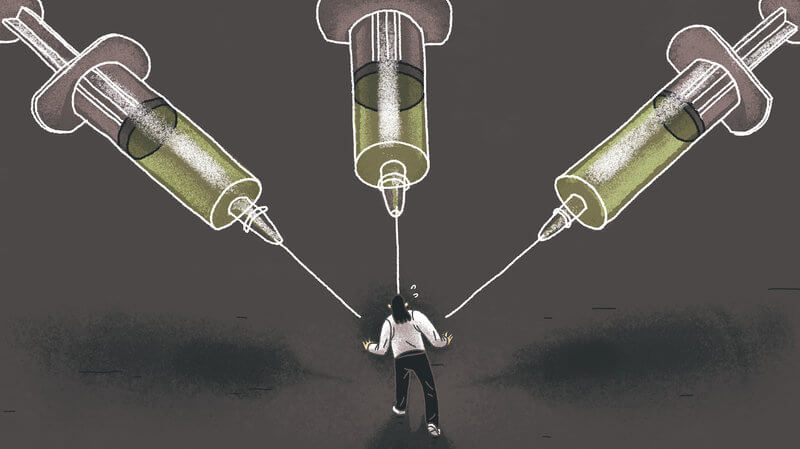
Needle Safety: What to Do Before and After a Needlestick Injury
By Doug Bennett, a contributor
Conservative estimates suggest U.S. health care workers--across all settings--receive over 600,000 needle stick injuries each year, half of which go unreported. This includes an average of 1,000 needle sticks and other sharps injuries each day in U.S. hospitals.
The circumstances surrounding each exposure are unique, and so are the corresponding risks. Nurses historically have sustained 49 percent of all percutaneous injuries. Still, all healthcare workers are at risk, and the single largest risk factor for an individual’s safety is not knowing what to do once a needlestick injury occurs.
 This lack of basic knowledge can significantly increase the risk of seroconversion after exposure to a pathogen.
This lack of basic knowledge can significantly increase the risk of seroconversion after exposure to a pathogen.
Time is another critical factor after a needlestick injury; however, hectic hospital and emergency room environments sometimes lead to shortcuts, which ultimately place healthcare workers and patients at even greater risk.
We’ve summarized the latest guidelines to help you prevent needlestick injuries, as well as how to treat and follow-up should an injury occur.
Preventing needlestick injuries
a.) Get vaccinated against diseases such as Hepatitis A and B; schedule periodic blood tests to monitor immunity and get boosters when necessary;
b.) Ensure the room you’re working in is well lit;
c.) Be mindful of potential distractions before working with syringes;
d.) Do not put hands where visibility is constrained, e.g., bed linens, trash bins;
e.) Cover existing cuts or abrasions with a waterproof bandage;
f.) Wear appropriate clothing and protective gear;
g.) Dispose of needles and sharps safely in appropriate containment systems;
h.) Do not recap needles using two hands; use the one-handed needle-capping technique instead;
i.) Promptly clean up any spills of bodily fluids while wearing gloves;
j.) Wash hands after direct contact with patients.
Treating needlesticks and other sharps injuries
a.) Wash the wound gently with soap and water: do not scrub the wound, which can worsen the injury.’
b.) Mucous membranes should be flushed with water or other sterile products;
c.) Do not apply suction/pressure or antiseptics--no evidence expressing blood from the wound or applying antiseptics will reduce the risk of transmission; however, antiseptic use is not contraindicated;
d.) Dry and cover the wound with a sterile dressing or bandage;
e.) Wash any other splashes of bodily fluids from your body with soap and water;
f.) Remove or change any potentially contaminated clothing;
g.) Seek medical attention immediately, discuss possible disease exposures, and get blood tests (including from the source patient) to determine if additional treatment is necessary;
h.) Get tetanus shot and any appropriate antibiotics, antiretrovirals, or post-exposure prophylaxis (PEP)--ideally within an hour of the exposure
i.) Request a written recovery plan or schedule from the treating physician to outline any necessary follow-up tests based on the unique circumstances and risks associated with your particular exposure
Follow-up steps
a.) Follow the established protocol in place at the hospital or other facility where the exposure occurred or treatment was sought;
b.) Complete an incident report and submit it to the appropriate occupational safety and health or infection control personnel:
• Date and time of exposure
• Procedure performed at the time of exposure
• Type of device(s) used
• Type and severity of exposure
• Source patient risk factors
• Your health status, including vaccinations received, prescriptions taken, pregnancy status, and any other relevant conditions or information
c.) If working on an assignment, contact your staffing agency as soon as possible and follow any specific guidelines they provide;
d.) Comply with the recovery plan devised by your care provider, e.g., retest for HIV or hepatitis exposure at appropriate intervals, and document all medically necessary follow-up testing and procedures
e.) Seek counseling to address any emotional impacts resulting from your injury;
f.) Review policies pertaining to your employee rights and responsibilities and your employer’s obligations to injured employees;
g.) Work with appropriate personnel at your hospital or care facility to review existing safety protocols and ensure they’re up-to-date, prominently displayed, and routinely communicated to all staff.
Resources:
What If A Needle sticks you? - Modern Medicine
What Should I Do If I Get a Needlestick? - The Hospitalist
Needlestick Safety and Prevention Study Module - ANA
Needlestick Safety and Prevention Act Summary - ANA
Preventing Needlestick Injuries in Healthcare Settings - NIOSH
Preventing Needlestick Injuries Among Healthcare Workers - WHO/ICN
How to Prevent Needlestick and Sharps Injuries - NIOSH
Keeping you safe on the job is our top priority at Med Travelers. Connect with an experienced recruiter to find your next job in one of the nation’s top healthcare facilities.
© 2016. AMN Healthcare, Inc. All Rights Reserved.


